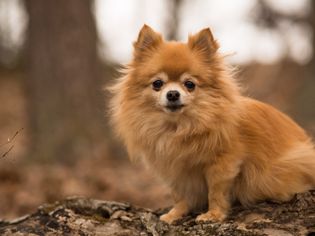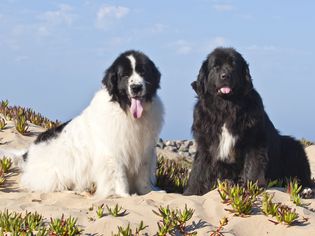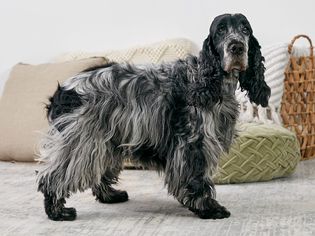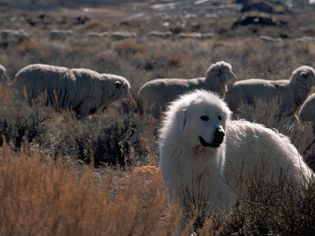The Pumi is a medium-sized herding dog from Hungary with signature corkscrew curls on its double coat, a curled tail, and a lean, athletic body. These adorable dogs are fearless workers and easily recognizable by their eye-catching fur. Bred to be a compact sheepdog, the Pumi was once responsible for moving flocks on narrow roads between pastures in western Hungary thanks to its penchant for gathering, driving, and keeping livestock under control.
Today, the Pumi is well-known for its exceptional intelligence and unique personality. This dog's charming and affectionate temperament, along with its expressive ears and facial character, make the Pumi both a cute family companion and a determined herding dog with boundless energy for work and play.
Breed Overview
Group: Herding
Height: 15 to 18.5 inches
Weight: 22 to 29 pounds
Coat: Curly, wavy, medium-length double coat
Coat Color: Black, fawn, gray, silver-gray, white, brown (some born gray or brown, which fades over time)
Life Span: 12 to 13 years
Temperament: Energetic, intelligent, protective, active, trainable
Hypoallergenic: No
Origin: Hungary
Characteristics of the Pumi
The Pumi is best-known for its athleticism and sincere devotion to the people it loves. These dogs are very protective of their families, but they're far more likely to alert their owners of suspicious strangers than to become aggressive thanks to their friendly personalities. As long as training and socialization begin early, they'll be fine sharing their home with children and other animals.
This breed is known for being vocal, so prospective owners should prepare for barking. Thankfully, since they have a very trainable temperament, they can learn to control their barking if it becomes excessive. Your Pumi will also do best with plenty of mentally engaging toys to prevent destructive behaviors from developing when boredom strikes. With plenty of exercise and attention, the Pumi can be a loyal companion to all members of your family.
| Affection Level | High |
| Friendliness | Medium |
| Kid-Friendly | Medium |
| Pet-Friendly | Medium |
| Exercise Needs | High |
| Playfulness | High |
| Energy Level | High |
| Trainability | High |
| Intelligence | High |
| Tendency to Bark | High |
| Amount of Shedding | Low |
History of the Pumi
The Pumi has often been referred to as the Hungarian herding terrier because of its terrier-like attributes, such as its quick movement, alert temperament, and lean, muscular body type. It was also given the nickname "the clown" for its playful personality and expressive face. This breed is thought to be a result of livestock trading between Hungary, France, and Germany.
It’s believed that three sheepdogs were originally bred in Hungary—the Mudi, Puli, and Pumi. The Puli is the oldest of the three, established as far back as A.D. 800. This ancestral Hungarian herding dog likely migrated with the Magyars from the Ural-Altay region between China and the Caspian Sea to the Carpathian Basin. About 300 to 400 years ago, the Puli was mixed with French and German herding dogs and terriers to create the Pumi. It's said that the Mudi evolved naturally from crosses of the Puli, Pumi, and German Spitz breeds.
The Pumi can also be traced back to herding and guard breeds from China and Tibet. This includes the Tsang Apso, a widespread breed in the region that was mistakenly called the Tibetan Terrier by Europeans. The Pumi was first considered a regional variant of the Puli, but by the early 1900s, the two dogs became standardized as their own separate breeds.
The international breed standard for the Pumi was approved in 1935. It became an officially recognized breed in the United States in 2011 and in the United Kingdom in 2015. The first Pumi dogs were imported to Finland in the early 1970s. Today, the breed is the most popular of all the herding dogs in Finland.
There are currently more than 2,000 Pumi dogs registered in Hungary, but notable populations are also found in Finland and Sweden. The Pumi is bred in smaller numbers in the United States, the United Kingdom, and Germany.
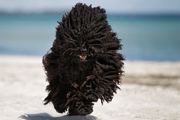
Pumi Care
While the Pumi is an especially trainable dog, it requires significant exercise and mental stimulation to be its best. Owners should also prepare for regular grooming to keep this dog's curly double coat in good condition.
Exercise
Your Pumi will thrive with at least one hour of exercise each day combined with play sessions, training lessons, or activities like agility sports to keep its mind occupied. These dogs are playful and still retain a strong herding drive, so homes that can provide an outlet for these instincts are best. Simple games like fetch can also be a fun option for owners to keep this dog active at home. The Pumi is agile and known to climb, so having a tall fence around the yard is ideal (along with training for a reliable recall). Aside from playing and training, your Pumi will be happy to join you for runs, hikes, bike rides, or any other outdoor adventure.
Grooming
The Pumi’s double coat is made up of a soft undercoat and a coarser, harsher outercoat. Occasional trimming and combing every three to six weeks will help prevent mats and tangles. For its curls to re-form, its coat should be wetted after combing (and be sure to skip the blow dryer after baths). During this process, owners may notice more stray fur than usual, but this dog's coat is typically low-shedding.
Training
The Pumi’s intelligence and alert nature make these dogs easy to train, and they seem to have an endless desire to work with their humans. Basic obedience lessons can begin when puppies are about eight weeks old. The Pumi also excels at advanced training for herding or canine sports as it grows older.
Some behavioral issues that can arise without proper training and exercise include digging, barking, and a tendency to herd people by nipping at their heels. While the Pumi makes a great watchdog, it's also likely to become an excessive barker. These behaviors should be discouraged early by redirecting the dog's attention to desired actions with rewards. Positive reinforcement methods are very effective, so it's best to avoid any types of training that involve punishment.
Common Health Problems
The Pumi breed is generally regarded as healthy, but like other purebreds, it's still prone to some inherited conditions. Responsible breeders strive to maintain high standards by testing adult dogs prior to breeding. If you plan to adopt a Pumi as a puppy, ask your breeder to provide the litter's medical history.
The following health issues are associated with this breed:
- Hip Dysplasia: Dysplasia is caused by a malformation in the dog's joints as they age. This condition may require surgery in severe cases to help your dog live comfortably.
- Luxating Patella: Similar to a "slip knee" in humans, this condition causes the knee to pop in and out of place.
- Degenerative Myelopathy (DM): This disease causes a breakdown of the white matter in your dog's spine, which often starts with signs like limb weakness and eventually leads to paralysis.
- Primary Lens Luxation (PLL): This painful eye disorder causes the lens of the eye to move out of place, which can lead to inflammation and serious vision problems.
Diet and Nutrition
The Pumi should perform well with high-quality commercial dog food or a home-prepared diet under veterinary supervision. Fresh, clean water should be available at all times for this active, high-energy breed.
These dogs may become overweight if they aren't receiving the correct portions and a generous amount of exercise, so be sure to monitor your Pumi's calorie consumption (including healthy treats). Talk to your veterinarian to determine a healthy diet and portion schedule based on your specific dog's age, weight, and activity level.
Where to Adopt or Buy a Pumi
If you think this breed is right for you, talk to other Pumi owners, reputable breeders, and rescue groups to learn more about its care. Since the Pumi is a somewhat rare breed in North America, it's not always likely to find these dogs in shelters, but you can check local rescue groups for Pumi dogs and similar breeds in need of forever homes.
When adopting a puppy from a breeder, it's essential to do your research. Ensure you're provided with the litter's medical history, allowed to meet their parents, and able to see that the dogs are raised in a comfortable, safe indoor location. Pumi puppies typically cost between $1,000 and $3,000, but prices can vary based on pedigree and availability.
Resources like the national breed club and the AKC can help you start your search:
- Hungarian Pumi Club of America
- Hungarian Pumi Club of America Rescue
- AKC Pumi Breeders
Pumi Overview
Very kid-friendly, great with other pets
Intelligent and eager to learn
Low-shedding coat
Requires regular grooming and considerable daily exercise
May bark excessively
Prone to destructive behaviors like chewing or digging when bored

More Dog Breeds and Further Research
If you love the Pumi, you may also like these similar herding breeds:
- Border Collie
- Polish Lowland Sheepdog
- Bouvier des Flandres
There's a whole world of dog breeds out there that can become your next best friend. With a little research, you can find the perfect match to join your family!
- Is a Pumi a Good Family Dog?
Affectionate and friendly, the Pumi makes a great family dog for owners that can keep up with its exercise needs. This breed does well with children and can live happily with other pets when socialized properly.
Are Pumi Dogs Easy to Train?Like many other herding breeds, the Pumi is an intelligent dog that's eager to please its owners. These dogs are fast learners and generally easy to train for both obedience and advanced lessons.
Does the Pumi Dog Shed?The Pumi's curly double coat is very low-shedding, so these dogs are a good breed choice for families with mild to moderate allergies. Owners may notice heavier shedding during grooming sessions.


